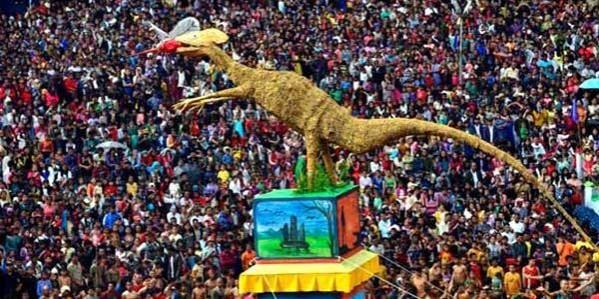
Known for the rich culture and colourful heritage, the state of Meghalaya is a popular place with festivals galore. The state is famous for music fests and zeal of the locals. One such festival is Behdienkhlam, which is a significant festival of Meghalaya. The festival is celebrated to pray for the good health, property and healthy harvest of the people.
Celebrated mostly in the Jaintia District of Meghalaya, Behdienkhlam is celebrated every year in the month of July after the sowing season the locals take it as a significant dance festival of the Jaintia tribe. Jowai, which is a well-known place in Jaintia hills, is the place where Behdienkhlam is celebrated with most enthusiasm.
Locals believe that Jowai was once a forest and was home to five deities, four stones and a river nymph. Even today, from all the four corners of Jowai town, the stones can be seen. A Mongolian tribe happened to appear in the region after the five deities wanted human habitation. In order to celebrate the presence of humans, the eldest deity named 'U-Mokhai' started a ceremonial dance and Behdeinkhlam started to be celebrated in Meghalaya.
How is Behdienkhlam celebrated
About seven days before the festival, a pig is sacrificed to the Thunder, and the locals call it Knia Pyrthat. The priests or the 'Wasan' then ring a brass bell at the point from where the forest begins.
In the sacred forest, tall trunks of the trees are felled and are left in the woods for a few days before the trunks are brought back to the town.
On the fourth day of Behdienkhlam, every house is visited by priests and young men. Using bamboo sticks, they beat the roof of every house to drive away evil spirits. While this is happening, drumbeats, cymbals and recitation of chants in Pnar language is also carried out.
A competition is conducted in which youngsters make 30-40 ft. tall structures using bamboo and colored papers.
The "Laho" Dance
Behdienkhlam is devoted primarily to entertainment and men and women participate in the dancing. They wear colourful attires to add to the festive spirit. Rather than dancing on the beats of drums and pipes, a cheerleader, who is a man, tells bawdy couplets, and onlookers roll with laughter.
At the end of the festival, football games are played with a wooden ball.
A hunting ritual is carried out during the festival and Cher iung blai or symbolic killing of the demons is also conducted.








